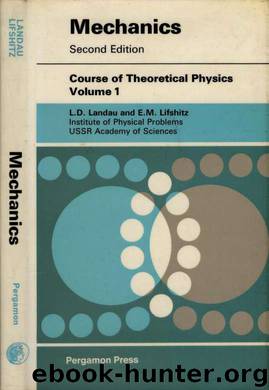Mechanics by L.D. Landau & E.M. Lifshitz

Author:L.D. Landau & E.M. Lifshitz
Language: eng
Format: epub
Tags: Physics; Equations of Motion; Collisions; Conservation Laws; Oscillations; Rigid Body; Cannonical Equations
Fig. 32
To calculate the value of/&, we notice that it is the value of/for which the two roots of the quadratic equation in & 2 (29.5) coincide; for/ = /&, the section CD reduces to a point of inflection. Equating to zero the discriminant
t The proof is given by, for example, N. N. BoGOLiuBOvandY. A. Mitropolsky,^}-^-totic Methods in the Theory of Non-Linear Oscillations, Hindustan Publishing Corporation, Delhi 1961.
of (29.5), we find e 2 = 3 A 2 , and the corresponding double root is ko 2 = 2e/3. Substitution of these values of b and e in (29.4) gives
32mWA 3 /3V3M. (29.7)
Besides the change in the nature of the phenomena of resonance at frequencies y x coo, the non-linearity of the oscillations leads also to new resonances in which oscillations of frequency dose to coo are excited by an external force of frequency considerably different from too-
Let the frequency of the external force y x -|coo> i-e. y = -^coo + e. In the first (linear) approximation, it causes oscillations of the system with the same frequency and with amplitude proportional to that of the force:
x d) = (4f/3mojo 2 ) cos(|a>o + e)t
(see (22.4)). When the non-linear terms are included (second approximation), these oscillations give rise to terms of frequency 2y x coo on the right-hand side of the equation of motion (29.1). Substituting x {1) in the equation
*< 2 > + 2AxW + coo 2 * (2) + rf> 2 + j8*e>3 = - a*< 1)2 ,
using the cosine of the double angle and retaining only the resonance term on the right-hand side, we have
x®>+ 2Ax< 2 > + co 0 2 * (2) + ox® 2 + fix®* = - (8a/ 2 /9w 2 co 0 4 ) cos(co 0 + 2e)t.
(29.8)
This equation differs from (29.1) only in that the amplitude /of the force is replaced by an expression proportional to / 2 . This means that the resulting resonance is of the same type as that considered above for frequencies y x coo, but is less strong. The function b(e) is obtained by replacing / by - 8a/ 2 /9wco 0 4 , and e by 2e, in (29.4):
& 2 [(2e-K& 2 ) 2 + A 2 ] = 16a 2 /4/81m4co 0 10 . (29.9)
Next, let the frequency of the external force be y = 2u>o + e. In the first approximation, we have x a) = — (//3mco 0 2 ) cos(2co 0 + e)t. On substituting x = x (1) + x (2) in equation (29.1), we do not obtain terms representing an external force in resonance such as occurred in the previous case. There is, however, a parametric resonance resulting from the third-order term proportional to the product x (1) x (2) . If only this is retained out of the non-linear terms, the equation for # (2) is
x® + 2\x®> + co 0 2 *< 2 > = - 2a*<%<2) or
W + 2\x®+a>o 2 \l ^7 cos(2co 0 + e)fl^ 2 ) = 0, (29.
Download
This site does not store any files on its server. We only index and link to content provided by other sites. Please contact the content providers to delete copyright contents if any and email us, we'll remove relevant links or contents immediately.
The Complete Stick Figure Physics Tutorials by Allen Sarah(7273)
Secrets of Antigravity Propulsion: Tesla, UFOs, and Classified Aerospace Technology by Ph.D. Paul A. Laviolette(5246)
Thing Explainer by Randall Munroe(3854)
The River of Consciousness by Oliver Sacks(3505)
The Order of Time by Carlo Rovelli(3102)
How To by Randall Munroe(2979)
A Brief History of Time by Stephen Hawking(2918)
I Live in the Future & Here's How It Works by Nick Bilton(2907)
The Great Unknown by Marcus du Sautoy(2621)
What If?: Serious Scientific Answers to Absurd Hypothetical Questions by Randall Munroe(2595)
Midnight in Chernobyl by Adam Higginbotham(2439)
Blockchain: Ultimate Step By Step Guide To Understanding Blockchain Technology, Bitcoin Creation, and the future of Money (Novice to Expert) by Keizer Söze(2415)
Networks: An Introduction by Newman Mark(2310)
The Meaning of it All by Richard Feynman(2275)
Easy Electronics by Charles Platt(2257)
The Tao of Physics by Fritjof Capra(2209)
Midnight in Chernobyl: The Untold Story of the World's Greatest Nuclear Disaster by Adam Higginbotham(2133)
When by Daniel H Pink(2062)
Introducing Relativity by Bruce Bassett(2053)
